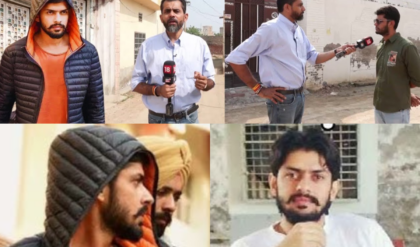The Lawrence Bishnoi Case: Unveiling the Gangs of North India
The Lawrence Bishnoi case has recently brought to light the intricate and dangerous world of North Indian gangs. Lawrence Bishnoi, a notorious gangster, has been at the center of numerous criminal activities, including issuing death threats to Bollywood star Salman Khan and being linked to the murder of Punjabi rapper Sidhu Moose Wala. His gang, which numbers around 700 members, is involved in various illegal activities across India, Canada, the United States, and the United Arab Emirates.
FULL VIDEO:
The Rise of Lawrence Bishnoi
Lawrence Bishnoi, born in 1991, first gained national attention in 2016 when he was involved in a jailbreak of a suspected Khalistani separatist. Since then, he has been linked to numerous criminal activities, including the murder of Sidhu Moose Wala in 2022. His gang has also claimed responsibility for the murder of Maharashtra minister Baba Siddique in 2024.
The Gang’s Operations
The Bishnoi gang is known for its involvement in drug trafficking, extortion, and targeted assassinations. The gang has strong connections with Sikh militant groups and has been accused of targeting Sikh activists who support the creation of an ethno-religious homeland in India called Khalistan. The gang’s operations have extended beyond India, with alleged involvement in criminal activities in Canada and other countries.
The International Dimension
The case has taken an international turn with allegations that the Bishnoi gang has been working in coordination with Indian government agents to target dissidents overseas. Canadian Prime Minister Justin Trudeau has accused Indian diplomats of colluding with the gang to carry out violence against Sikh activists in Canada. The Royal Canadian Mounted Police (RCMP) has also implicated the Bishnoi gang in the assassination of Sikh separatist leader Hardeep Singh Nijjar in 2023.
The Legal Battle
Lawrence Bishnoi has been in and out of jail since 2010, facing multiple charges ranging from trespassing to murder. Despite his incarceration, he continues to run his gang from behind bars, using technology and intermediaries to carry out his orders. The Indian government has been actively pursuing his extradition from Canada, where he is believed to have fled after the murder of Sidhu Moose Wala.
The Impact on Society
The Lawrence Bishnoi case has highlighted the pervasive influence of organized crime in North India and its ability to operate across borders. The case has also raised concerns about the safety of high-profile individuals and the need for stringent measures to combat gang violence. The public and media reaction to the case has been one of shock and outrage, with calls for stronger law enforcement and judicial action against the gangsters.
The Role of Technology
Technology has played a significant role in the operations of the Bishnoi gang. From encrypted communication channels to sophisticated surveillance techniques, the gang has leveraged modern technology to evade law enforcement and coordinate their activities across multiple countries. This has made it increasingly challenging for authorities to track and apprehend gang members.
Coordination with International Agencies
Given the cross-border nature of the Bishnoi gang’s activities, Indian law enforcement agencies have been working closely with international counterparts. This includes sharing intelligence, coordinating operations, and conducting joint investigations to dismantle the gang’s network. The collaboration has been crucial in tracing the gang’s financial transactions and identifying key members involved in international criminal activities.
The Impact on the Entertainment Industry
The threats to high-profile individuals like Salman Khan have sent shockwaves through the Indian entertainment industry. Actors and filmmakers have become more cautious, with increased security measures being implemented at film sets, events, and personal residences. The situation has raised awareness about the vulnerabilities of celebrities and the need for robust protective measures.
Public Awareness and Community Response
The Bishnoi case has also sparked public discussions about the root causes of organized crime and the socio-economic factors that contribute to the rise of gangs. Community leaders, activists, and policymakers are advocating for comprehensive strategies that address poverty, lack of education, and unemployment, which are often exploited by criminal organizations to recruit members.
Government’s Response
The Indian government has vowed to crack down on organized crime and enhance the safety of its citizens. This includes legislative reforms, increased funding for law enforcement agencies, and the establishment of special task forces dedicated to combating gang violence. The government’s commitment to tackling organized crime is seen as a crucial step towards restoring public confidence and ensuring the rule of law.
The Path Forward
As the legal battle against Lawrence Bishnoi and his gang continues, there is a growing recognition of the need for sustained efforts and international cooperation to dismantle organized crime networks. Law enforcement agencies are focusing on cutting off the gang’s financial resources, disrupting their communication channels, and apprehending key members.
Conclusion
The Lawrence Bishnoi case is a stark reminder of the challenges posed by organized crime in North India. The case has not only exposed the criminal activities of the Bishnoi gang but also the international dimensions of their operations. As the legal battle continues, the hope is that justice will be served, and the influence of such gangs will be curtailed. The efforts of law enforcement, government agencies, and international cooperation will be crucial in dismantling these criminal networks and ensuring a safer future for all.
News
Shah Rukh Khan receives DEATH threat after Salman Khan: Mumbai police begin investigation!
Shah Rukh Khan Receives Death Threat After Salman Khan: Mumbai Police Begin Investigation In a shocking turn of events, Bollywood superstar Shah Rukh Khan has received a death threat, following a similar threat made to fellow actor Salman…
Abhishek Bachchan’s Assertive Reply to Aishwarya Rai and Public Amidst Divorce Speculations
Amidst Divorce, Abhishek Gave a Strong Reaction to Aishwarya Rai! Gave a Sharp Reply to People! In the midst of swirling divorce rumors, Bollywood’s star couple, Abhishek Bachchan and Aishwarya Rai Bachchan, are once again under the intense glare…
Abhishek Bachchan Responds Firmly Amid Divorce Rumors with Aishwarya Rai
Amidst Divorce, Abhishek Gave a Strong Reaction to Aishwarya Rai! Gave a Sharp Reply to People! In the midst of swirling divorce rumors, Bollywood’s star couple, Abhishek Bachchan and Aishwarya Rai Bachchan, are once again under the intense glare…
Amidst Divorce, Abhishek Gave a Strong Reaction to Aishwarya Rai! Gave a Sharp Reply to People!
Amidst Divorce, Abhishek Gave a Strong Reaction to Aishwarya Rai! Gave a Sharp Reply to People! In the midst of swirling divorce rumors, Bollywood’s star couple, Abhishek Bachchan and Aishwarya Rai Bachchan, are once again under the intense glare…
Aishwarya Rai Reacts Strongly to Abhishek Bachchan’s Alleged Letter to Nimrat Kaur Post-Separation
Aishwarya Rai’s Shocking Reaction to Abhishek Bachchan’s Nasty Letter with Nimrat In a dramatic turn of events, Bollywood actress Aishwarya Rai Bachchan has reacted strongly to a letter allegedly written by her estranged husband, Abhishek Bachchan, to Nimrat Kaur….
Aishwarya Rai’s Explosive Response to Abhishek Bachchan’s Controversial Letter to Nimrat Kaur
Aishwarya Rai’s Shocking Reaction to Abhishek Bachchan’s Nasty Letter with Nimrat In a dramatic turn of events, Bollywood actress Aishwarya Rai Bachchan has reacted strongly to a letter allegedly written by her estranged husband, Abhishek Bachchan, to Nimrat Kaur….
End of content
No more pages to load








